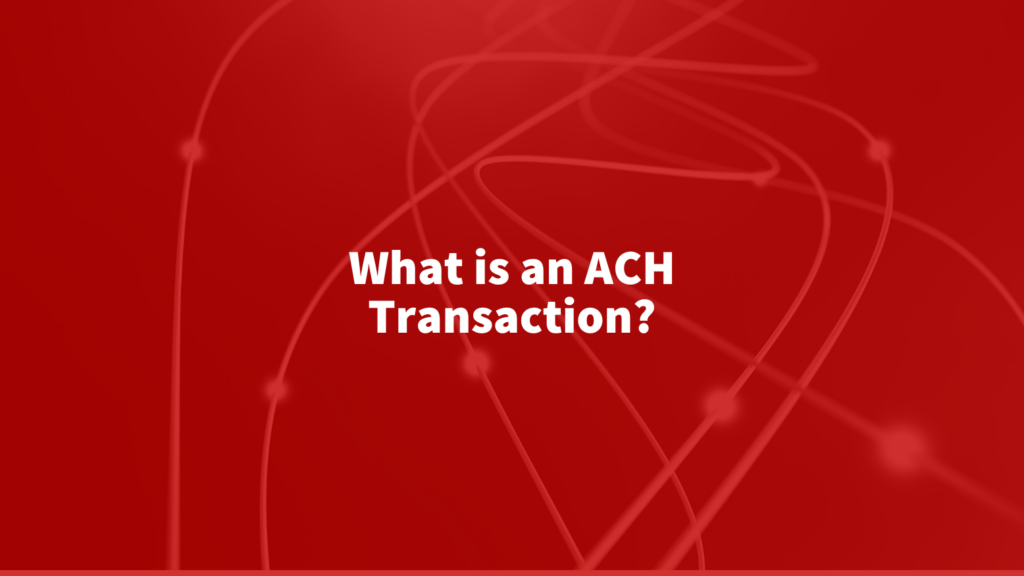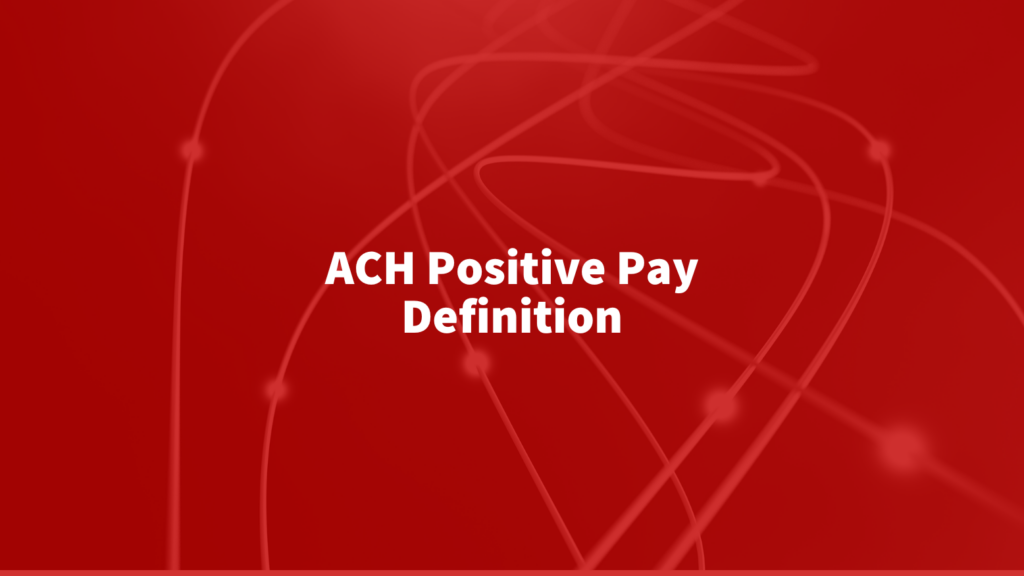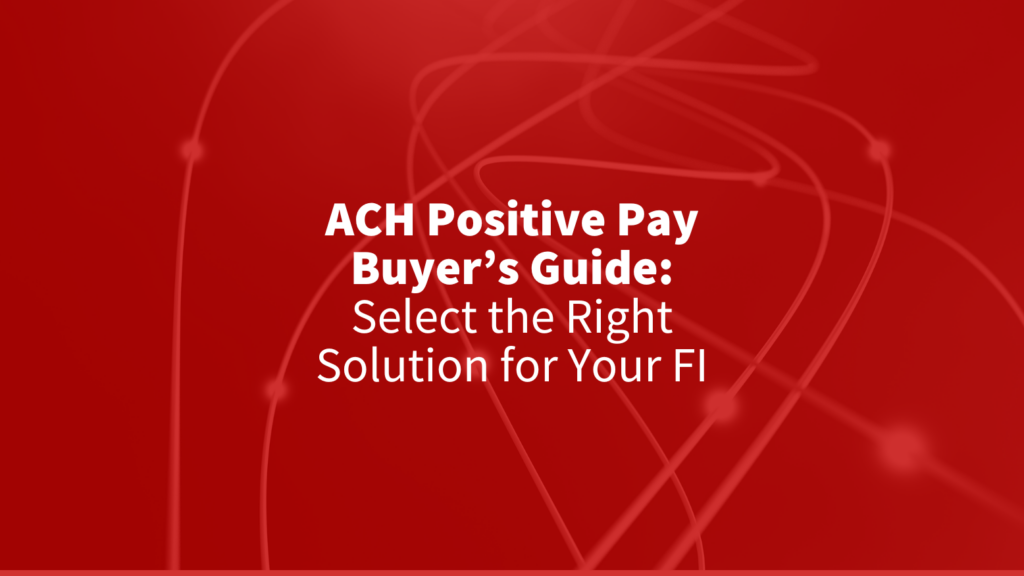Why ACH Positive Pay is Essential for Fraud Prevention: A Guide for Financial Institutions & Businesses

Financial institution stakeholders know that electronic payment volumes are surging with no end in sight. Financial institutions (FIs) and their business clients also face increasing threats from ACH fraud, because wherever the money goes, scammers follow.
ACH transactions—processed through the Automated Clearing House (ACH) network—provide a convenient way to move funds electronically, but without the proper safeguards, they can expose both FIs and business account holders to significant fraud risks. Implementing ACH Positive Pay is a proactive step toward preventing unauthorized ACH transactions and safeguarding financial assets.
In this blog, we’ll explore how ACH Positive Pay works, why it’s essential for FIs and their business clients, and how to select the right solution. Additionally, we’ll highlight real-world examples of recent ACH fraud and how a strong ACH Positive Pay solution could have mitigated the risks.

What is an ACH Transaction?
ACH transactions are electronic payments used by businesses for a variety of purposes, including payroll, vendor payments, and bill payments. These transactions are typically categorized as ACH credits (where funds are pushed from an account) or ACH debits (where funds are pulled from an account).
FIs play a key role in processing these transactions through the ACH network, but without adequate fraud protection, they can leave both themselves and their clients vulnerable to unauthorized ACH activity.
Definition and Types of ACH Transactions
ACH (Automated Clearing House) transactions are a form of electronic payments that enable businesses to transfer funds between bank accounts efficiently. These transactions are categorized into two main types: ACH credits and ACH debits.
ACH credits are typically used for direct deposits, such as payroll disbursements and vendor payments, where funds are pushed from the payer’s account to the recipient’s account.
ACH debits are used for recurring expenses like utility bills and insurance premiums, where funds are pulled from the payer’s account. The popularity of ACH transactions stems from their convenience, speed, and cost-effectiveness, making them a preferred method for many businesses.
How ACH Transactions Work
ACH transactions operate through the Automated Clearing House network, a secure system that processes electronic payments. When a business initiates an ACH transaction, the payment details are sent to the ACH network.
The network then routes the payment to the recipient’s bank, which verifies the transaction and credits the recipient’s account accordingly. This streamlined process allows for various applications, including payroll, vendor payments, and bill payments, making ACH transactions a versatile tool for managing electronic payments.
What is the ACH Network?
The ACH network is a large-scale electronic system that allows financial institutions to move money securely between accounts in the U.S. It handles everything from direct deposits to bill payments, making it one of the most essential payment systems for businesses and FIs.
However, as the use of ACH transactions grows, so do the risks of fraud, prompting the need for comprehensive fraud prevention tools like ACH Positive Pay. ACH Positive Pay service is a crucial tool for businesses to manage and monitor authorized electronic transactions.
How Can ACH Transactions Be Compromised?
Fraudsters target ACH transactions by initiating unauthorized debits, often exploiting account information obtained through phishing scams, data breaches, or social engineering. ACH fraud can lead to significant financial losses for business account holders, and FIs are not immune to the operational and reputational damage that follows. To combat fraud, it is crucial for businesses to implement protective measures to reduce the risk of losses from unauthorized transactions.

Recent Examples of ACH Fraud
Supply Chain Fraud – June 2024
A U.S.-based manufacturing company was hit with ACH fraud when fraudsters impersonated a trusted supplier and altered payment instructions. Over $300,000 in fraudulent ACH debits were processed before detection, causing financial strain on both the business and the FI processing the payments.Employee Payroll Fraud – January 2024
A healthcare organization faced a payroll breach where fraudsters altered ACH payroll details for 50 employees. Unauthorized debits went unnoticed until significant damage was done, resulting in major financial losses for both the organization and the FI. An ACH Positive Pay solution could have flagged these irregularities.Vendor Payment Fraud – September 2023
A national retailer experienced a fraudulent ACH debit scheme that diverted over $200,000 intended for a legitimate vendor. The absence of an ACH fraud filter led to a long and costly recovery process for the FI and their business client.
ACH Positive Pay: A Definition
ACH Positive Pay is an automated fraud prevention tool that monitors ACH debit activity, flagging unauthorized or suspicious transactions based on custom rules set by the financial institution or business account holder. If a transaction doesn’t meet the pre-set criteria, it’s flagged for review, allowing the FI or business to return the debit before it posts to the account.
ACH Positive Pay not only prevents unauthorized transactions but also maintains a detailed record of all activity and decisions, simplifying future audits or investigations.

How Does ACH Positive Pay Work?
ACH Positive Pay works by allowing FIs and their business clients to configure specific filters or rules to block unauthorized ACH debits. These filters can include parameters like trusted vendors, transaction types, or payment limits, allowing for a customized fraud prevention approach.
Positive pay systems are crucial in reducing check fraud. Variations like Payee Positive Pay offer enhanced security by verifying the payee’s name against provided lists, addressing the limitations of traditional positive pay methods, especially in in-person transactions.
Here are the key features:
ACH Transaction Block
An ACH transaction block prevents unauthorized ACH debits from being processed without prior approval. Reverse positive pay is a variation where businesses monitor their own checks instead of relying on the bank. FIs and their business clients can configure the system to block all incoming debits until they’ve been manually reviewed, giving full control over which transactions are processed.
ACH Transaction Filters
Transaction filters allow FIs and business account holders to specify certain types of ACH transactions that should be automatically approved, while others are flagged for review. Payee Positive Pay is an enhanced service that verifies the payee’s name against a pre-approved list to prevent check fraud. This ensures that only pre-approved debits, such as those from trusted vendors, are processed.
Alerts and Information Reporting
Real-time alerts keep both FIs and their clients informed of any flagged transactions. Notifications can be sent via email or SMS, ensuring immediate action is taken to block unauthorized payments. Detailed reports also allow FIs and business clients to track and review their ACH transactions, improving both security and financial oversight.
Common Uses of ACH Positive Pay
Businesses commonly use ACH Positive Pay to safeguard against fraudulent transactions and unauthorized payments. Some typical applications include:
Preventing ACH debits from unauthorized vendors.
Detecting and preventing suspicious ACH transactions.
Reducing the risk of financial losses due to fraudulent activities.
Enhancing visibility and control over electronic payments.
Strengthening internal controls to minimize the risk of unauthorized transactions.
By leveraging ACH Positive Pay, businesses can protect themselves from the inherent risks associated with ACH transactions, ensuring their electronic payments are secure and reliable.
The Benefits of ACH Positive Pay for FIs and Business Clients
ACH Positive Pay offers numerous benefits to financial institutions and their business account holders:
Proactive Fraud Prevention: By allowing FIs and their business clients to set custom filters and blocks, ACH Positive Pay reduces the risk of unauthorized or fraudulent transactions.
Real-Time Alerts: Immediate notifications allow for quick action, ensuring fraud is caught before it impacts the institution or its clients.
Detailed Record-Keeping: ACH Positive Pay maintains a comprehensive log of transaction decisions, aiding in audits and reconciliation processes.
Greater Transaction Control: Both FIs and their clients can control which transactions are processed, ensuring unauthorized payments are flagged and blocked in real time.
Implementing ACH Positive Pay as a Business
Implementing ACH Positive Pay involves a collaborative effort between businesses and their financial institutions to establish a protocol for filtering and verifying ACH transactions. From the business client side, the process typically includes the following steps:
Enrolling in an ACH Positive Pay program offered by the financial institution.
Providing a list of approved vendors and setting transaction rules.
Configuring filters and parameters to monitor ACH transactions.
Reviewing and approving or rejecting flagged transactions.
Certainly! Here’s a concise version focusing on how a financial institution can start researching, reviewing, vetting, and implementing a Positive Pay provider, matching the length of the section designed for businesses:
Steps for Financial Institutions to Implement ACH Positive Pay
1. Research Providers: Begin by identifying a list of Positive Pay service providers. Focus on those with strong industry reputations and robust security features. Utilize industry reviews and peer recommendations to narrow down your options.
2. Evaluate Features: Assess each provider’s capabilities, particularly their flexibility in setting rules, ease of integration with your current systems, and the level of customer support provided. Key features to consider include real-time transaction monitoring, customizable alerts, and comprehensive fraud management tools.
3. Vet Providers: Request demos to see each system in action, and reach out to other institutions for feedback on their experiences with the provider. Ensure the provider meets all relevant compliance and security standards.
4. Implement the Chosen System: Select the provider that best aligns with your needs and arrange for a phased implementation that includes staff training and a pilot testing phase. Monitor the system’s effectiveness regularly and gather feedback to ensure it meets your fraud prevention goals.
By implementing ACH Positive Pay, businesses and their financial institutions can significantly reduce the risk of fraudulent transactions and unauthorized payments, ensuring greater security and control over their financial operations.
Best Practices for ACH Positive Pay
To maximize the effectiveness of ACH Positive Pay, FIs and businesses should adhere to several best practices:
Regularly review and update approved vendor lists and transaction rules to ensure they remain current.
Set up multiple filters and parameters to detect and flag suspicious transactions.
Implement a systematic process for reviewing and approving or rejecting flagged ACH transactions.
Provide comprehensive training to employees on ACH Positive Pay procedures and protocols.
Continuously monitor ACH transaction activity to identify and address any irregularities promptly.
By following these best practices, businesses can enhance the security of their ACH Positive Pay system and effectively combat fraudulent transactions.

ACH Positive Pay Buyer’s Guide: Selecting the Right Solution
As ACH fraud continues to rise, it’s essential for FI leaders to select an ACH Positive Pay solution that meets the specific needs of their institution and business account holders. Below are key features and considerations to look for when evaluating an ACH Positive Pay solution.
1. Flexible Configuration Options
Your financial institution and business clients may have diverse needs depending on transaction volumes, client profiles, and resource availability. Choose a solution that offers customizable configuration options, allowing you to set decision rules, notification settings, and approval workflows that are tailored to your institution’s needs.
Positive Pay by AFS provides:
Configurable decision and approval rules.
User-specific dashboards and branded notifications.
Full control over user permissions and approval authority.
2. Comprehensive ACH Exception Handling
Efficient exception handling is crucial for preventing unauthorized transactions. Look for a solution that can quickly detect and manage exceptions.
Positive Pay by AFS offers:
ACH decision rules that automatically flag potentially fraudulent transactions.
Real-time exception notifications.
Automated exception handling, allowing ACH debits to be blocked or returned based on pre-set rules.
3. Advanced Fraud Detection Through Transaction Filters
A robust ACH Positive Pay solution should offer transaction filters that allow business clients to screen ACH debits based on approved criteria, such as vendors or transaction types.
Positive Pay by AFS includes:
ACH Transaction Filters for pre-approved payments.
Pre-decision notifications that allow FIs to review flagged transactions.
Detailed transaction tracking and reporting.
4. Real-Time Alerts and Reporting
Real-time alerts are essential for catching fraud quickly. Online banking serves as a platform for notifying customers about discrepancies in check details, acting like an integrated alarm system that alerts users of any suspicious activity related to their financial transactions. A strong ACH Positive Pay solution should provide instant notifications via email or SMS, as well as detailed reporting features.
Positive Pay by AFS includes:
Real-time alerts for both FI users and business clients.
Customizable dashboards with detailed exception and transaction reporting.
5. Scalable for Institutions of All Sizes
Ensure the solution you choose can scale with your institution’s needs. Whether you manage a community bank or a larger financial institution, the ACH Positive Pay solution should accommodate varying transaction volumes without compromising performance.
Positive Pay by AFS offers:
Scalable pricing structures, suitable for institutions of all sizes.
API integration for seamless data automation and scaling.
Billing capabilities to charge clients for exception decisions, generating additional revenue.
The ACH Positive Pay Benefits are Clear
ACH Positive Pay is a critical fraud prevention tool for both financial institutions and their business clients. By implementing a flexible, scalable solution with comprehensive exception handling and advanced fraud detection features, FIs can stay ahead of increasingly sophisticated ACH fraud schemes.
Positive Pay by AFS delivers a robust and customizable solution that meets the needs of FIs of all sizes, ensuring both financial security and operational efficiency.
